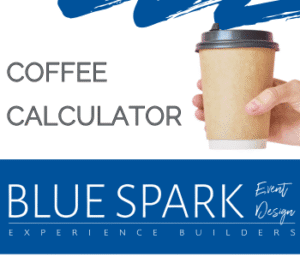
Coffee: How Much Do You Really Need?
Calculating the amount of coffee needed for a meeting depends on several factors.
As meeting planners, we’re tasked not only with designing the flow of ideas but also with ensuring that the elixir of productivity, coffee, flows freely.
So, how do we nail down the perfect brew-to-guest ratio? Well, it’s a bit like concocting the perfect blend—part science, part artistry.
First Things First, Gather Intel
You need to gather the headcount, demographics, duration of the affair, and the locale.
Are we basking in the sun or huddling against a chill? This can make an impact on consumption.
And let’s not forget to gauge the caffeine cravings of our esteemed guests. Are they coffee lovers? Or tea drinkers?
After all, a gathering of youthful gamers might lean more toward a Mountain Dew than a robust Arabica.
How is It Served?
Therefore, the first thing you need to know is how much you can get out of a gallon of coffee.
This is a good measurement for your estimates. A gallon yields:
- 21 6-ounce cups
- 16 8-ounce cups
- 10 12-ounce cups
So knowing what size cups your hotel or venue is utilizing for your event is important.
Also, take into consideration, that most often, you are serving black drip coffee with a variety of sugars and milks to mix in.
If you have a group who loves frothy or foaming coffees, they will most likely end up in line at the in-house coffee shop than your coffee station.
Ways to Caffeinate
Should we cater to the caffeine aficionados or the decaf devotees?
This can be driven by demographics. According to studies, men are more likely to drink caffeinated coffee and women are more likely to drink decaffeinated.
However, even if your demographics are 100% men, don’t forget that there are a variety of reasons people drink decaffeinated coffee like negative medicine interactions, negative heart reactions, high blood pressure and more.
Having a decaf option is recommended.
How to Calculate?
Number of Guests & Time
According to Meetings and Conventions magazine, they calculate coffee based on the number of guests and the time of day.
For mornings, they suggest a gallon of regular joe per 30 souls and a gallon of decaf for every 75.
For those who enjoy tea, a gallon of hot water per 75 guests.
For breaks, they suggest a gallon of regular and decaf joe per 50 guests and 1 gallon of tea per 75 guests.
Percentage
Another way to estimate coffee can be to utilize a percentage of guests.
For every hundred souls, 60% will likely reach for the regular, 25% for the decaf, and a select 10% for the soothing embrace of tea.
We often calculate with percentages with the demographics of the group and the budget in mind.
*See the coffee calculator to practice estimates.
How To Order?
Two options present themselves: pay by the gallon (on consumption per gallon) or opt for the all-day java extravaganza (all day beverage service based on a per person price and a time-frame).
Consider your crowd carefully; if they’re the type to live on caffeine, an all-day package might be the best choice.
Don’t Forget
Brew and estimate wisely, my friends, and may you never run out of coffee at an event. Cheers!

